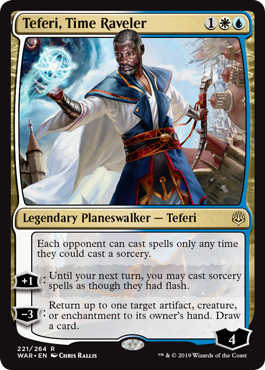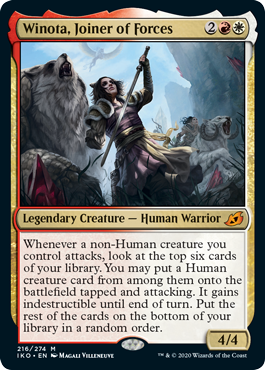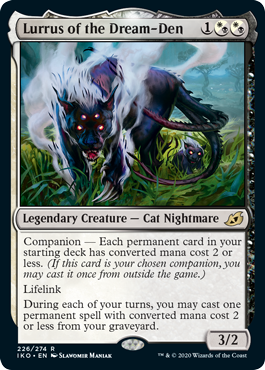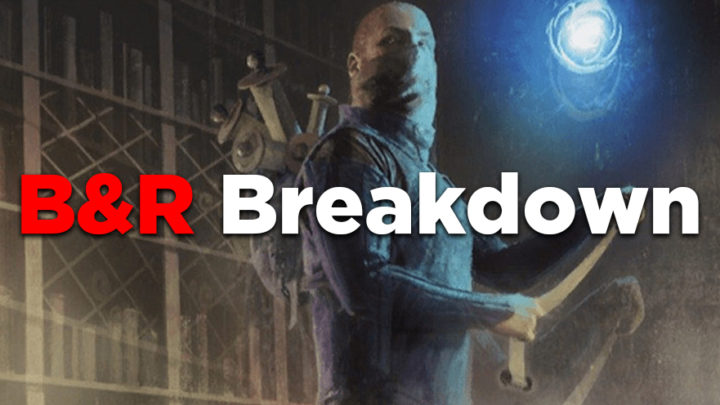Last week, Wizards of the Coast released a much-anticipated Banned and Restricted announcement that has ramifications for Standard, Historic, and companion cards as we know them.
As always, I recommend reading the official announcement yourself to get the long-form reasoning behind the changes. But for convenience:
- Agent of Treachery and Fires of Invention are banned in Standard
- Agent of Treachery and Fires of Invention are suspended (banned) in Historic
- The “companion” keyword has been errata’d, significantly weakening and changing those creatures in all formats.
Setting aside the unusual special case of the companion errata — for now — let’s look at the new bans. Were they enough? Plenty of players seem to have expected more, a sign of just how tired people are of the current Standard environment. The 15-card laundry list of bans half-jokingly suggested by some pundits was never going to happen, sure. But to only ban two? One of which (Agent) wasn’t even close to the top of people’s hit lists? That is a very conservative compromise on Wizards’ part.
THE STANDARD ISSUE

Standard has gone from crisis to crisis ever since War of the Spark released. Starting with Teferi, Time Raveler, we have seen wave after wave of highly-pushed threats that replace either the cards or mana spent to play them. In addition to Hydroid Krasis and Wilderness Reclamation, we now have Nissa, Who Shakes the World, Narset, Parter of Veils, Agent of Treachery, Fires of Invention, Uro, Titan of Nature’s Wrath, Elspeth Conquers Death, Shark Typhoon, and Yorion, Sky Nomad. Even Lukka, Coppercoat Outcast can force interaction against the target of his -2 while still demanding that you remove him, lest he use another -2 the next turn.
No matter what, if you spend a card removing or negating these threats after they resolve, you are falling behind. The fact that so many of them synergize means they are regularly played together — a pile of bombs that all demand answers and leave you up on cards.
These decks might normally be vulnerable to counterspell-heavy tempo and control lists, but Teferi makes those an extremely risky proposition. They might normally be vulnerable to aggressive decks getting under their big spells, but almost all of the good one- and two-drops vanished last rotation. We also lost a lot of the available burn spells — even Lightning Strike!
When you consider this withering of aggro against the amount of incidental lifegain and board control out of the greed decks, it looks grim indeed. Teferi himself is one of the best defensive tempo cards ever printed, wasting a turn (and sometimes two!) from any creature deck. Consider also that we have very playable ramp spells — and three- and four-mana sweepers in white, red and black — and you can see why the aggro decks aren’t forcing the midrange decks to make harder deck-building choices.
WINOTA STAYS FREE?

When players couldn’t go under these midrange decks or win a fair game of Magic against them, they inevitably adopted them. The metagame in Standard has become an arms race of linear, greedy strategies. Historic is slightly healthier, with the older aggro cards giving Teferi and co. a genuine threat to worry about, but has still struggled to develop past the greed meta.
Instead, we see fringe strategies arise which are specifically adapted to the current environment. Last month I wrote about how the RWx Cycling decks are a unique outcome of this meta, dependent as they are on specific, easily countered threats. The Winota, Joiner of Forces decks in both Standard and Historic fall into the same group.
While the Winota decks have an incredibly high ceiling, their weakness to interaction gives them a concerningly low floor. There is a wealth of instant-speed removal capable of dealing with Winota before your opponent can declare attackers and trigger her. Outside of that, killing their mana dorks or token generators meaningfully slows them down. And unlike the snowballing midrange decks, this list can actually run out of gas if you answer their early plays. If your opponent holds back their Winota in fear of counterplay, and then you wrath their board, that Winota is no longer game-ending.
Aside from the potential pace, everything about these Winota decks is fair Magic. But because the meta has completely departed from fair Magic, nobody feels they have the tools to answer them. Look at the list of removal spells in the tweet I linked — how many of those see play? Even in Historic, the closest thing to spot removal across high-performing decks is Bonecrusher Giant. So, we end up with Winota and Zenith Flare opposite the Teferi decks as the two poles pulling every deck in Standard apart. Building to beat one leaves you vulnerable to the other, so you may as well just choose one of them to play.
Does this mean Wizards should have banned Winota? I don’t think so. Wizards clearly preferred to try and hobble her by banning Agent of Treachery (a card already due to rotate out this year) while preserving her future potential. But I think they could have gone one step further and banned another rotating card — Teferi, Time Raveler. With Teferi gone, it would be far easier for players to hedge against the remaining “best cards” like Winota and Wilderness Reclamation. Instead, we’re due for several more months of frustration, and the many otherwise-playable cards held down by Teferi will never see their moment in the sun.
THE COMPANION ERRATA

Not banning Teferi may be seen as another missed opportunity, but at least Wizards used this announcement to act decisively against another community concern: the Ikoria companions. This attempt to encourage offbeat deck-building and create new design space pushed the envelope too far, and we were suddenly faced with a world where each game of Constructed Magic would be played around the same ten (or realistically, six) cards. Even after spot bans for Lurrus, Lutri, and Zirda, something had to be done, and Wizards has done it.
Now, rather than casting your companion directly from your sideboard, you must pay three generic mana to put it into your hand. Then you can cast it normally by paying its mana cost. Adding the companion to hand is a special game action, so it doesn’t use the stack, but you can only do it at sorcery speed.
Changing the companion mechanic as a whole is a very bold move. Normally, Magic cards are only errata’d to correct templating errors; errata do not significantly change the function of the card. But altering the mechanic was essential, and the new version addresses a number of concerns. Adding a three-mana tax just straight up nerfs these cards, which gives us hope that they will become more fringe options than an integral part of all deck-building. It also opens up potential for counterplay with discard spells. This should help break up the repetitive play patterns that companions were criticized for.
WHENCE FROM HERE?
This nerf will fundamentally change the role of companions in competitive play. Lurrus, Yorion, Keruga and Obosh — already the best of the bunch — are the ones most likely to see play after this errata, since they work much better as a late-game play than say, Kaheera. We will probably still see companions in Standard and Historic going forward — especially Yorion, whose synergy with other midrange threats is simply too good to ignore — but you should no longer feel bad for brewing without them. And that is a definite win.
I haven’t really touched on the Fires of Invention ban yet, but I think it was the right call. This card has already had plenty of time in the spotlight, and it was definitely not going away by itself. Wizards acknowledged that Fires had made it extremely difficult to design fun haymaker cards for future sets. I want to live in a world where Lukka is the linchpin of an awesome red creature deck with Yidaro, Wandering Monster, not a cog in the relentless engine of Jeskai Fires. Fires was both a member of the “self-replacing/must-remove” threat club and a mana-fixing device that encouraged players to jam the rest of them in one deck. Banning it was another win for this announcement.
The changes leave Bant Ramp, Temur Reclamation, RW Cycling and Jund Sacrifice as the presumptive best decks in Standard. There may end up being a UW Control list which can hang with them, but I’m skeptical. Until Teferi rotates, nothing indicates that we will see a viable aggro deck, or even anything resembling traditional midrange — despite the presence of some impressive tools in GBx. While this B&R has set us up for a brighter Standard post-rotation and patched holes in other formats, it won’t change the stagnant feel of the current environment.
The future of Historic seems harder to predict. With its creature decks already stronger, there is now much more of a chance to challenge Teferi strategies, as those will not have easy access to Yorion to pad out their plays. Plus, losing Obosh matters much less in a format with strong aggressive cards up and down the curve.
It’s also worth noting that although Winota can still pull out Angrath’s Marauders, losing Agent means that the deck can be chump-blocked reliably, and you’ll get to untap with all your lands ready to fight back. I expect that predictions of her dominance will prove overblown, and that Historic may end up being the more balanced format people were crossing their fingers for. I intend to find out for myself — join me next week as I unveil a suite of meta-defying new Historic brews!

Tom’s fate was sealed in 7th grade when his friend lent him a pile of commons to play Magic. He quickly picked up Boros and Orzhov decks in Ravnica block and has remained a staunch white magician ever since. A fan of all Constructed formats, he enjoys studying the history of the tournament meta. He specializes in midrange decks, especially Death & Taxes and Martyr Proc. One day, he swears he will win an MCQ with Evershrike. Ask him how at @AWanderingBard, or watch him stream Magic at twitch.tv/TheWanderingBard.

